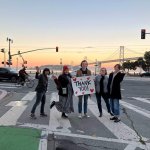What the new state law on daylighting could (and should) mean for San Francisco
A simple, proven way to protect pedestrians
Last October, not only did Governor Newsom sign the speed camera bill we fought so hard for, but another important bill for pedestrians became law.
Assembly Bill 413 now makes it illegal for all drivers everywhere in California to park within 20 feet of any marked or unmarked crosswalk. This essentially adds what’s known as ‘daylighting’ to all intersections. And this is a highly effective way to save lives and better protect people walking. Read the AB 413 legislation.
By creating clear sight lines at intersections, daylighting reduces crashes by up to 30%. Take a deep dive on daylighting in this recent Bloomberg article. And daylighting helps drivers, too – not just in terms of seeing pedestrians, but being able to make safe turns in the face of oncoming traffic.
Many intersections in San Francisco already have daylighting created with ‘no parking’ red paint.
In fact, the City’s most recent Vision Zero Action strategy committed to completing red painted daylighting on all designated high-injury streets – the 12% of streets where 68% of crashes occur – by the end of 2024. This is a crucial safety improvement for dangerous intersections, and Walk SF has pushed for faster progress for years, even doing our own audits of where daylighting was still needed on the high-injury network.
Generally, the SFMTA had added painted daylighting of 10 feet of curb versus the 20 feet that’s now law. And 20 feet of daylighting is safer.
Depending on the size of vehicles parked near an intersection (which are bigger by the day, it seems), 10 feet of daylighting isn’t enough for a clear sight line when there’s a tall car or truck. Children and people using wheelchairs are often hard to see when there is only 10 feet of daylighting.
Hoboken, New Jersey hasn’t had a traffic death in seven years, and extensive daylighting is one of the top reasons credited for why.
That’s because Hoboken doesn’t just do 20 feet of painted daylighting at every intersection – they put things in the space to prevent drivers from parking temporarily there. Posts, bike racks, and planters are added. And this is crucial for daylighting to actually make us all safer. (Here’s a great read on Hoboken’s approach to daylighting and food for thought on applying this to bigger cities.)
Expanding and enhancing daylighting in San Francisco
So how can California’s new daylighting law AB 413 move San Francisco in a bolder direction with daylighting? The SFMTA has started removing parking meters that are within 20 feet of intersections. And SFMTA Parking Enforcement Officers will issue warnings to drivers parking within 20 feet of an intersection for the next year (read more on SFMTA’s website). The agency’s plan currently does not include adding red paint at all intersections to reflect this new law, but expects that drivers will learn to follow the law starting in 2025.
But, of course just because a law is on the books doesn’t mean it will be followed, especially in a city where parking is at a premium. We do not want theoretical daylighting.
That’s why we need SFMTA to think bigger about daylighting, especially with the City’s reaching its ten-year milestone with its Vision Zero policy later this year. Now’s the time to take some of the most powerful, proven street design solutions out there and go big in the next decade. The new daylighting law is a great opportunity to do so.
What’s exciting is that there are things already happening here that can be built on and brought to scale. Just yesterday, a bikeshare station was installed on a daylighting area on Fell Street just down the street where I live, creating a dreamy 50+ feet of daylighting – and the SFMTA has put bikeshare and bike parking corrals in many other daylighting zones, too.
On Page Street at Fillmore, the first community parklet of the city was just built in November in a daylighting space. Planters, benches, and more could transform more parking into parks. Check this out:
 And if daylighting at a high-injury intersection isn’t getting something like this adorable parklet, at a minimum it needs posts to prevent drivers from parking there.
And if daylighting at a high-injury intersection isn’t getting something like this adorable parklet, at a minimum it needs posts to prevent drivers from parking there.
The SFMTA needs to do more than paint red curbs on the high-injury network – they need a year-by-year plan for how and where adding curb paint and features to prevent parking will be strategically implemented in the full 20 feet near the crosswalk so San Francisco can become like Hoboken ASAP.
The City’s next Vision Zero Action Strategy is the perfect place to push for this. You’ll be hearing more soon from us on how you can help shape and level-up the City’s approach to safe streets – and be sure the SFMTA harnesses daylighting to the max.
Daylighting done right saves lives, and will also reduce those heart-stopping near-misses we all face too often walking in San Francisco.
Excited about daylighting? Us too! Make sure you are signed up for Walk SF’s newsletter and considering making a donation to Walk SF today. And email your ideas to marta@walksf.org.




